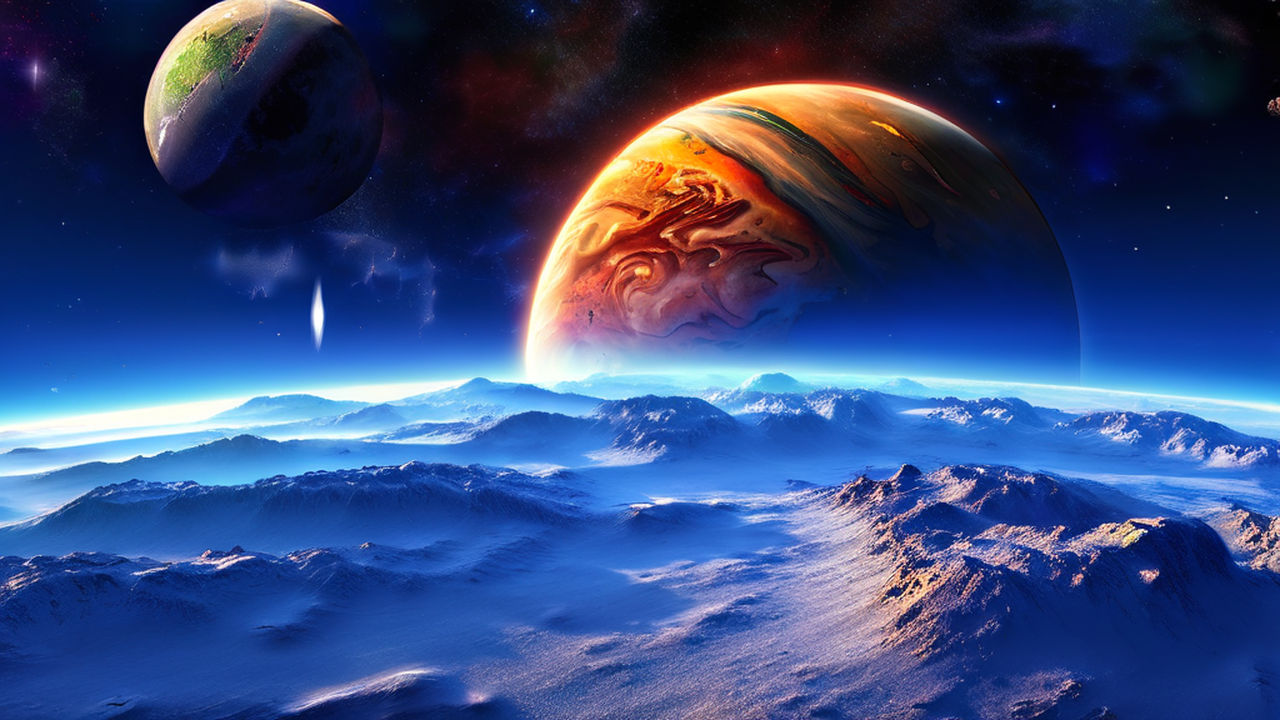Introduction
The solar system is a vast cosmic neighborhood comprising the Sun, planets, moons, asteroids, comets, and other celestial objects bound together by gravity. It is the system that includes Earth and all the celestial bodies that orbit the Sun. Studying the solar system provides crucial insights into the workings of the universe and our place within it.
What is the Solar System?
The solar system refers to the collection of celestial bodies, including the Sun, planets, moons, asteroids, comets, and other objects, that orbit around the Sun. It extends from the Sun’s gravitational influence, encompassing a vast expanse of space.
Importance of Studying the Solar System
Studying the solar system is vital for understanding the fundamental principles of astronomy, planetary science, and astrophysics. It allows us to explore the origins, evolution, and dynamics of celestial bodies, providing valuable insights into the formation of planets, the conditions for life, and the vastness of the cosmos. Additionally, studying the solar system helps us comprehend the potential threats posed by asteroids and comets, impacting Earth’s future and our ability to explore and inhabit other worlds.
The Sun: Our Solar System’s Star
The Sun stands as the central and most prominent figure in our solar system, serving as the primary source of light, heat, and energy. Its immense size and composition, coupled with its dynamic processes, shape the environment of the entire solar system.
Size and Composition
The Sun boasts a colossal diameter of about 1.4 million kilometers, making it approximately 109 times larger than Earth. It is primarily composed of hydrogen (about 74%) and helium (about 24%) with trace amounts of heavier elements like oxygen, carbon, and iron. The Sun’s core, where nuclear fusion occurs, is incredibly hot, reaching temperatures of around 15 million degrees Celsius.
Energy Production
At the core of the Sun, intense pressure and temperature conditions enable nuclear fusion reactions to take place. Hydrogen atoms combine to form helium, releasing vast amounts of energy in the process. This energy radiates outward through the Sun’s layers, providing the heat and light that sustain life on Earth.
Solar Flares and Sunspots
The Sun’s surface is not a serene, uniform sphere but rather a dynamic environment characterized by magnetic activity. Solar flares are sudden bursts of energy that occur when magnetic energy stored in the Sun’s atmosphere is released. These eruptions can release the energy equivalent to millions of hydrogen bombs and produce intense radiation that can affect space weather and communications on Earth.
Sunspots, on the other hand, are temporary dark patches on the Sun’s surface caused by magnetic activity inhibiting convection. These regions are cooler than their surroundings and are often associated with solar flares and other solar phenomena. Monitoring sunspots helps scientists track the Sun’s activity and predict potential disruptions to technology and infrastructure on Earth.
Understanding the size, composition, energy production, and dynamic behavior of the Sun is essential for comprehending the broader dynamics of our solar system and the universe beyond. As the primary source of light, heat, and energy, the Sun plays a central role in shaping the environment and conditions necessary for life on Earth and other celestial bodies within the solar system.
Planets in Our Solar System
The solar system is home to a diverse array of planets, each with its own unique characteristics and features. Among these are the inner planets, which include Mercury, Venus, Earth, and Mars, each offering its own insights into the formation and evolution of rocky worlds.
The Inner Planets
The inner planets, also known as terrestrial planets, are characterized by their rocky compositions and relatively small sizes compared to the gas giants. They are located closer to the Sun and have solid surfaces.
Mercury: The Closest Planet to the Sun
Mercury holds the distinction of being the closest planet to the Sun, orbiting at an average distance of about 57.9 million kilometers. Its proximity to the Sun results in extreme temperature variations, with surface temperatures ranging from scorching highs to freezing lows. Mercury’s surface is marked by vast plains, rugged mountains, and numerous impact craters, offering clues to its tumultuous history and formation.
Venus: The Hottest Planet in the Solar System
Venus, often referred to as Earth’s sister planet due to its similar size and composition, is the hottest planet in the solar system despite not being the closest to the Sun. Its thick atmosphere traps heat, creating a runaway greenhouse effect that results in surface temperatures exceeding 450 degrees Celsius. Venus’ surface is shrouded in dense clouds of sulfuric acid, obscuring its features from view.
Earth: Our Home Planet
Earth, the third planet from the Sun, is the only known celestial body to support life. Its moderate temperatures, liquid water, and protective atmosphere make it a haven for a diverse array of organisms. Earth’s surface is marked by vast oceans, towering mountains, and sprawling continents, providing habitats for billions of species, including humans.
Mars: The Red Planet
Mars, often called the Red Planet due to its rusty-colored surface, has long captivated human imagination as a potential destination for exploration and colonization. It features a diverse landscape that includes towering volcanoes, deep canyons, and dry riverbeds, hinting at a complex geological history. Recent discoveries of water ice beneath its surface raise intriguing questions about the possibility of past or present life on Mars.
The inner planets offer valuable insights into the processes that shaped our solar system and continue to shape our understanding of planetary formation and evolution. Studying these rocky worlds provides crucial clues to the conditions necessary for life and the potential for habitable environments beyond Earth.
The Gas Giants
In contrast to the inner, rocky planets, the outer solar system is dominated by massive gas giants—Jupiter, Saturn, Uranus, and Neptune. These immense worlds are primarily composed of hydrogen and helium and lack solid surfaces, instead featuring thick atmospheres and swirling cloud systems.
Jupiter: The Largest Planet
Jupiter, the largest planet in our solar system, is a behemoth with a diameter over 11 times that of Earth. It boasts a dynamic atmosphere filled with colorful bands of clouds and the iconic Great Red Spot—a massive storm system larger than Earth. Jupiter’s intense magnetic field generates powerful auroras and traps charged particles, creating a hazardous radiation environment.
Saturn: The Ringed Giant
Saturn is renowned for its spectacular ring system, consisting of thousands of individual ringlets made primarily of ice and dust particles. Beneath its rings lies a massive planet with a deep atmosphere marked by swirling storms and bands of clouds. Saturn’s largest moon, Titan, is the only moon in the solar system with a substantial atmosphere, featuring lakes of liquid methane and ethane on its surface.
Uranus: The Tilted Planet
Uranus stands out for its unique tilt, with its axis of rotation nearly parallel to its orbital plane, causing it to appear to roll on its side as it orbits the Sun. This peculiar orientation results in extreme seasonal variations, with each pole experiencing long periods of sunlight and darkness. Uranus’ atmosphere is composed mainly of hydrogen and helium, with traces of methane giving it a blue-green hue.
Neptune: The Windy Planet
Neptune, the farthest planet from the Sun, is a frigid world characterized by its deep blue coloration and turbulent atmosphere. It boasts the fastest winds in the solar system, with gusts reaching speeds of up to 2,000 kilometers per hour. Neptune’s atmosphere features dark storms, including the infamous Great Dark Spot, reminiscent of Jupiter’s Great Red Spot.
The gas giants offer a glimpse into the outer reaches of our solar system and provide valuable insights into the dynamics of planetary atmospheres, magnetospheres, and moons. Their immense size and unique features make them fascinating objects of study, shedding light on the processes that shape the worlds beyond Earth.
Dwarf Planets and Other Celestial Bodies
While the major planets in our solar system capture much of the attention, there are also smaller, intriguing bodies that populate the vast expanse beyond. Among these are dwarf planets like Pluto and Eris, as well as unique objects like Ceres, which offer valuable insights into the diversity and complexity of our celestial neighborhood.
Pluto: The Dwarf Planet
Once considered the ninth planet in the solar system, Pluto was reclassified as a dwarf planet by the International Astronomical Union in 2006. Located in the distant Kuiper Belt, Pluto orbits the Sun in a highly elliptical path. Its surface is covered in icy plains, mountains, and frozen methane and nitrogen. Pluto also boasts a complex system of moons, including Charon, its largest companion.
Ceres: The Largest Asteroid
Ceres holds the distinction of being the largest object in the asteroid belt between Mars and Jupiter and was classified as a dwarf planet in 2006. It is unique among asteroids due to its spherical shape and relatively large size, with a diameter of about 940 kilometers. Ceres is believed to contain large amounts of water ice beneath its surface, raising intriguing questions about its potential as a habitat for microbial life.
Eris: The Farthest Known Dwarf Planet
Eris is one of the farthest known objects in our solar system, located in the scattered disc region beyond the Kuiper Belt. It gained fame in 2005 when its discovery prompted a reevaluation of the definition of a planet, ultimately leading to the reclassification of Pluto. Eris is similar in size to Pluto and is composed primarily of ice and rock. Its discovery shed light on the existence of other large bodies in the outer reaches of the solar system.
These dwarf planets and other celestial bodies offer valuable insights into the diversity and complexity of our solar system. Studying these objects provides crucial information about the processes of planetary formation and evolution, as well as the dynamics of the distant regions beyond the major planets. As our understanding of these bodies continues to grow, so too does our appreciation for the richness and variety of worlds that inhabit our cosmic neighborhood.
Moons and Satellites
While planets often take center stage in discussions about our solar system, moons and satellites play crucial supporting roles, offering insights into planetary dynamics, geological processes, and potential habitats for life.
Earth’s Moon: Luna
Earth’s moon, known as Luna, is the fifth-largest moon in the solar system and has captivated humans for millennia with its ethereal beauty and influence on our planet’s tides. Luna is thought to have formed from the debris of a giant impact between Earth and a Mars-sized object early in the solar system’s history. Its surface is marked by vast plains, craters, and mountain ranges, providing a window into the geological processes that have shaped our own planet.
Jupiter’s Moons: A Diverse Array
Jupiter boasts a diverse array of moons, numbering at least 79 confirmed satellites and potentially many more awaiting discovery. Among the most famous are the four largest moons—Io, Europa, Ganymede, and Callisto—known as the Galilean moons after their discoverer, Galileo Galilei. These moons exhibit a wide range of features, including active volcanoes on Io, subsurface oceans on Europa, and ancient cratered terrains on Callisto. Jupiter’s moons provide valuable insights into tidal heating, planetary geology, and the potential for extraterrestrial life.
Saturn’s Moons: Titan and Enceladus
Saturn’s moons also offer a wealth of scientific intrigue, with two in particular standing out for their unique characteristics. Titan, the largest moon of Saturn, is the only moon in the solar system with a dense atmosphere, primarily composed of nitrogen with traces of methane and ethane. It features lakes, rivers, and seas of liquid hydrocarbons on its surface, making it an intriguing target for future exploration.
Enceladus, a much smaller moon of Saturn, has garnered attention for its geologically active surface and subsurface ocean beneath a layer of ice. Geysers of water vapor and icy particles erupt from its south polar region, hinting at the presence of hydrothermal vents and potentially habitable conditions beneath its icy crust.
These moons and satellites offer windows into the diverse environments and processes at work throughout our solar system. From the barren landscapes of our own moon to the potentially habitable oceans beneath the icy shells of moons like Europa and Enceladus, these celestial bodies provide tantalizing opportunities for exploration and discovery.
Asteroids, Comets, and Meteoroids
In addition to planets, moons, and satellites, the solar system is home to a multitude of smaller celestial bodies, including asteroids, comets, and meteoroids. These objects, scattered throughout the vast reaches of space, play important roles in the formation and evolution of our cosmic neighborhood.
Asteroid Belt
The asteroid belt is a region of space located between the orbits of Mars and Jupiter, where millions of rocky bodies known as asteroids orbit the Sun. These asteroids range in size from tiny pebbles to large objects hundreds of kilometers in diameter. While the asteroid belt contains a significant amount of mass, the total mass of all the asteroids combined is less than that of Earth’s moon. Collisions between asteroids occasionally result in fragments breaking off and entering Earth’s atmosphere as meteoroids.

Kuiper Belt
Beyond the orbit of Neptune lies the Kuiper Belt, a vast region of space populated by icy bodies, including dwarf planets, comets, and other small objects. The Kuiper Belt is home to objects such as Pluto, Eris, and Haumea, as well as countless smaller bodies. These objects are believed to be remnants from the early solar system and provide valuable insights into its formation and evolution. Some Kuiper Belt objects, known as “short-period” comets, have orbits that bring them close to the Sun, where they develop characteristic comas and tails.
Oort Cloud
The Oort Cloud is a theoretical region of space located far beyond the Kuiper Belt, stretching nearly halfway to the nearest star. It is believed to be the source of long-period comets, which have highly elliptical orbits that bring them close to the Sun only once every few thousand to millions of years. The Oort Cloud is thought to contain billions of icy objects, remnants from the early solar system, which were gravitationally influenced by the outer planets and ejected to the far reaches of space. While the Oort Cloud has never been directly observed, its existence is supported by the orbits of long-period comets and computer simulations of solar system dynamics.
These regions of space— the asteroid belt, Kuiper Belt, and Oort Cloud— offer valuable insights into the history and dynamics of our solar system. Studying these diverse collections of celestial bodies provides clues to the processes that shaped our cosmic neighborhood and continue to influence its evolution over billions of years.
Space Exploration
Humanity’s exploration of space has yielded remarkable discoveries and expanded our understanding of the universe. From missions to distant planets to the search for extraterrestrial life, space exploration continues to inspire awe and curiosity, driving us to push the boundaries of scientific knowledge and technological innovation.
Missions to the Planets
Throughout history, numerous spacecraft have been launched to explore the planets of our solar system, providing valuable data and insights into their compositions, atmospheres, and geological features. These missions have ranged from flybys and orbiters to landers and rovers, each designed to study specific aspects of planetary science.
For example, NASA’s Voyager probes, launched in 1977, conducted flybys of Jupiter, Saturn, Uranus, and Neptune, providing unprecedented images and data of these distant worlds. The Mars rovers, including Spirit, Opportunity, and Curiosity, have explored the surface of the Red Planet, searching for signs of past or present life and studying its geology and climate.
Recent missions, such as NASA’s Juno spacecraft orbiting Jupiter and the Cassini-Huygens mission to Saturn, have provided unprecedented views of these gas giants and their moons, revolutionizing our understanding of their atmospheres, magnetic fields, and moons.
The Search for Extraterrestrial Life
One of the most profound questions driving space exploration is whether life exists beyond Earth. Scientists have long speculated about the possibility of life on other planets, moons, or even within our own solar system. The search for extraterrestrial life encompasses a wide range of approaches, from studying the potential habitability of other worlds to searching for biosignatures in the atmospheres of exoplanets.
Missions like NASA’s Kepler Space Telescope have discovered thousands of exoplanets orbiting other stars, some of which may possess conditions conducive to life. The upcoming James Webb Space Telescope promises to further expand our ability to study the atmospheres of these distant worlds, potentially detecting signs of life.
Closer to home, astrobiologists are studying extreme environments on Earth, such as deep-sea hydrothermal vents and Antarctic subglacial lakes, to better understand the limits of life and where to search for it beyond our planet. Missions to Mars, Europa, and Enceladus are actively searching for evidence of past or present microbial life, driven by the tantalizing possibility of finding extraterrestrial organisms within our own solar system.
Conclusion
The exploration of the solar system is an ongoing adventure that continues to captivate the imagination and curiosity of humanity. From the scorching surface of Mercury to the icy depths of the Kuiper Belt, each celestial body offers a unique story waiting to be told.
Through space missions, scientific research, and technological innovation, we have gained unprecedented insights into the formation, evolution, and dynamics of our cosmic neighborhood. We have marveled at the towering volcanoes of Mars, studied the intricate rings of Saturn, and ventured to the outer reaches of the solar system in search of new worlds and possibilities.
But our journey is far from over. As we continue to explore and study the planets, moons, and asteroids of our solar system, we are driven by the quest for knowledge, the pursuit of discovery, and the desire to unravel the mysteries of the cosmos.
The exploration of space is not just a scientific endeavor; it is a testament to the human spirit of curiosity, exploration, and discovery. It reminds us of our place in the universe and the boundless potential that lies beyond the stars.
As we look to the future, let us continue to push the boundaries of space exploration, to boldly go where no one has gone before, and to inspire future generations to dream, explore, and discover the wonders of the cosmos.
Together, we will continue to unlock the secrets of the solar system and beyond, forging new paths of exploration and discovery that will shape the future of humanity for generations to come.















No Comments
Leave a comment Cancel